|
 Secure Site
Secure Site
|
 |
Archive for the 'Zen Timers' Category
 meditation increases compassion Maitryadisu balani
The cultivation of friendliness creates inner strength. (Yoga Sutra III.24)
We typically think of our emotional range as something that is fixed and unchanging—a reflection of the personality we’re born with. But research is revealing the possibility that we may be able to cultivate and increase our ability to feel the emotional state of compassion. Researchers have found that feeling connected to others is as learnable as any other skill. “We are trying to provide evidence that meditation can cultivate compassion, and that you can see the change in both the person’s behavior and the function of the brain,” Lutz says.
So what does compassion look like in the brain? To find out, Lutz and his colleagues compared two groups of -meditators—one group whose members were experienced in compassion meditation, and the other a group whose mambers were not—and gave them the same instructions: to generate a state of love and compassion by thinking about someone they care about, extend those feelings to others, and finally, to feel love and compassion without any specific object. As each of the participants meditated in-side the fMRI brain scanners, they were occasionally interrupted by spontaneous and unexpected human sounds—such as a baby cooing or a woman screaming—that might elicit feelings of care or concern.
All of the meditators showed emotional responses to the sounds. But the more experienced compassion meditators showed a larger brain response in areas important for processing physical sensations and for emotional responding, particularly to sounds of distress. The researchers also observed an increase in heart rate that corresponded to the brain changes. These findings suggest that the meditators were having a genuine empathic response and that the experienced meditators felt greater compassion. In other words, compassion meditation appears to make the brain more naturally open to a connection with others.
These meditation techniques may have benefits beyond the experience of spontaneous compassion. A study by psychology professor Barbara Fredrickson and her colleagues at the University of North Carolina, Chapel Hill, and the University of Michigan, found that a seven-week lovingkindness meditation course also increased the participants’ daily experience of joy, gratitude, and hope. The more participants meditated, the better they felt. Participants also reported a greater sense of self-acceptance, social support, purpose in life, and life satisfaction, while experiencing fewer symptoms of illness and depression. This study provides strong evidence that chipping away at the illusion of separation can open us up to a far more meaningful connection to life.
adapted from Yoga Journal by Kelly McGonigal
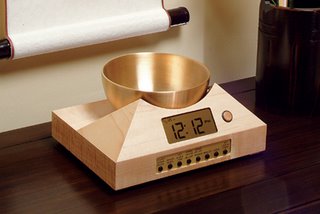 Zen Timepiece, a brass singing bowl clock and timer for meditation Now & Zen
743 Pine St.
Boulder, CO 80302
(800) 779-6383
Posted in Bamboo Chime Clocks, intention, Meditation Timers, mindfulness practice, Now & Zen Alarm Clocks, Well-being, Zen Timepiece by Now & Zen, Zen Timers
 mindfulness meditation Put it into Practice.
Mindfulness requires concentration, but rather than concentrate on any one object, we concentrate on the moment and whatever is present in that moment.
To begin, take a comfortable seat. Set your Zen Timer for 20 minutes. Bring attention to your breath by placing your awareness at your belly and feeling it rise and fall. This will help you tune in to the sensorial presence of the body. Once you
feel settled, widen your awareness to include all the sensations in your body as well as any thoughts or feelings.
Imagine yourself as a mountain. Some thoughts and feelings will be stormy, with thunder, lightning, and strong winds. Some will be like fog or dark, ominous clouds. Inhaling, note “mountain.” Exhaling, note “stable.” Use the breath to focus on the present moment; cultivate the ability to weather the storm. If you find yourself swept up in
a thought or emotion, notice it and simply return to the breath. The key is to pay attention to the ever-changing process of thinking rather than to the contents of your thoughts. As you begin to see that they are indeed just thoughts, they will begin to lose their power. You will no longer believe everything you think! Continue to watch and become mindful of your thoughts, feelings, and sensations for 5 to 20 minutes. Remember to set your Zen Timepiece to signal the end to this meditation.
adapted from Yoga Journal, by Kelly McGonigal
 Zen Timepiece, a meditation timer with bowl/gong Now & Zen
1638 Pearl Street
Boulder, CO 80302
(800) 779-6383
Posted in Bamboo Chime Clocks, intention, Meditation Timers, Meditation Tools, mindfulness practice, Now & Zen Alarm Clocks, Well-being, Zen Timepiece by Now & Zen, Zen Timers
 mediation and prayer Praying has a healing power.
A study by the Californian cardiologist Randolf Byrd helped inspire Larry Dossey to get involved in the healing power of prayer. In 1988 Byrd studied 393 heart patients. They were randomly divided into two groups using a double-blind technique, which means that neither the patients, nor the doctors or nurses knew to which group the patients belonged. Catholic and protestant prayer groups were given the names and health conditions of patients from the first control group and every day they directed their prayer to someone from that group. No prayers were said for the patients from the second control group. The group for which prayers were said needed five times fewer antibiotics than the other group, had three times less lung oedema and no one needed intubation to help them breathe, as opposed to 12 people in the other control group.
Larry Dossey has since become an authority in the area of ‘medicine at a distance’. He is more than convinced that prayer works: ‘Studies have irrefutably proven that people on a spiritual path – whereby meditation or prayer play a role – live an average of 7-13 years longer than those who are not. Moreover, cancer and heart disease are significantly less prevalent among those who pray or meditate. Prayer has an effect on nearly every living organism it has been tried on: people, various cells and tissue, animals, plants and organisms such as bacteria, fungi and yeast. At least 130 controlled laboratory experiments have been done.’
‘Prayer is communicating with the creative powers of the universe, with the extrasensory. There are different types of prayer: the appeal for something for yourself, the meditation in which you ask something for someone else, veneration, plea… In every case we go beyond our mind, which tends to think that it can solve everything by itself.’
Prayer to Dossey is not something holy that is only reserved to pious churchgoers: ‘Everyone can pray, even if you don’t believe in God. A friend of mine prays to “To whom it may concern”. Research clearly indicates that the intention of the prayer is important to the result. When you pray, do so with your whole heart, like a child, from a place of wonder, innocence and sincerity.’ One more tip: ‘There is not just one good way to pray. You can pray for something specific, give thanks or simply ask for help. When facing something difficult, for instance: “Come on God, help me out here.” It works! Try to find your own way to pray. If your wording becomes too formal, it often loses its power.’ Dossey remembers once sitting in a room during a lecture by a theologian. Someone asked: ‘How exactly should you pray?’ Her answer: ‘It’s very simple, ask God.’
 Dark Oak Zen Alarm Clock with Chime, a Meditation Timer Now & Zen
1638 Pearl Street
Boulder, CO 80302
(800) 779-6383
Posted in Bamboo Chime Clocks, Meditation Timers, Meditation Tools, mindfulness practice, Well-being, Zen Timepiece by Now & Zen, Zen Timers
 mindful walking When you apply a few simple techniques, you can turn your daily walk into a rewarding practice.
What is mindful walking? It’s a technique that uses awareness of the mind/body connection to improve the quality of your walking experience on all levels. By approaching a walk in a mindful way, you make it a practice like yoga, meditation, or tai chi; every session brings new insights and challenges. As in yoga, you think about your body position, breathing, movements, and awareness, turning inward and outward at the same time. You’re working to get fit, and to improve your life as a whole. Treat walking as a practice, and it will become not only something you do with your legs but also a way to bring your mind, body, and spirit into balance.
Five Steps to Make Walking a Mindful Practice
Identify your intention. The key to any mindful activity, intention provides focus and motivation, elevating your practice from routine to ritual. What is your intention? To walk for an hour every day? To develop a sense of centeredness and calm? To reduce stress? Your goals and intentions will evolve as you evolve. Let them, as long as they keep you in line with your higher sense of purpose — and keep you moving forward.
Be consistent. A true practice requires ongoing attention. Of course, it’s natural to feel resistant at times, no matter what kind of activity you do. Your mind will create a thousand excuses not to walk today. Don’t let these passing thoughts distract you from your deeper intention. Get moving; start walking around your office or home, or wherever you are. You can quiet the mind by moving your body and get yourself back on track.
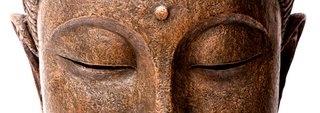 train your mind to focus Train your mind to focus. The mind loves — and craves — engagement. Without something to focus on, it will tend to wander, taking your practice with it. By learning to focus, you will be able to walk more efficiently.
Listen to your body. As with any relationship, the connection between mind and body depends on how well one listens to the other. Our tendency is to try to rule the body with the brain; however, they are more like equal partners, offering feedback and direction as you go. Listen to what your body is trying to tell you by noticing any sensations that come up while you’re walking. You may feel energized as your leg muscles engage or relaxed as your breathing deepens. If you detect any complaint from your body, such as pain or discomfort, identify the source. Then make small adjustments in your technique and see whether the sensation lessens.
Embrace the process. Goals provide a greater context for your practice. But building patient awareness of the process is even more important. Sometimes walking will feel easy and rewarding; other times, more like a chore. As part of a mindful practice, you accept the challenge as part of the process and continue to stick with it. My tai chi master sees difficulty as an opportunity — a lesson to be learned. Accepting all of these parts of the process lies at the heart of making walking a mindful exercise.
adapted from Body + Soul Magazine, April/May 2006
 Meditation Timer, The Digital Zen Alarm Clock in Solid Walnut Now & Zen
1638 Pearl Street
Boulder, CO 80302
(800) 779-6383
Posted in Japanese Inspired Zen Clocks, mindfulness practice, Now & Zen Alarm Clocks, Uncategorized, Well-being, Zen Timers
 how to cultivate compassion Cultivate equanimity in the face of life’s ups and downs, and find deeper access to joy.
A lot of people I know avoid reading the paper first thing in the morning—being confronted with all of the injustices and bad deeds in the world is an unsettling way to start the day. It’s difficult to read about the latest corporate finance scam or the obscenity of human trafficking and keep your peace of mind, and it’s even harder to know how to respond. The conflict feels even more immediate when you witness an unjust act firsthand, or are yourself the recipient of one, whether it’s having your wallet stolen, your car broken into, or any sort of hurtful behavior directed your way. The answer to this problem could be upeksha, the fourth of the brahmaviharas.
This understanding of upeksha as equanimity stresses the importance of balance. A balanced heart is not an unfeeling heart. The balanced heart feels pleasure without grasping and clinging at it, it feels pain without condemning or hating, and it stays open to neutral experiences with presence. Insight meditation teacher Sharon Salzberg speaks of equanimity as a “spacious stillness of mind,” within which we can remain connected to others and all that happens around us, while remaining free of our conditioned habit of grasping at the pleasant and pushing away the unpleasant.
Calm Within
One way to experience equanimity is to experiment with mindfulness meditation. Rather than fixing attention on a single object such as the breath or a mantra, mindfulness meditation involves the moment-to-moment awareness of changing objects of perception. Mindfulness is like a floodlight, shining awareness on the whole field of experience, including sensations, emotions, and thoughts as they arise and pass away in the dynamic, ever-changing flux that characterizes the human experience of body and mind. Mindfulness allows you to see the nature of the unfolding process without getting caught in reactivity, without identifying with your sensations, emotions, and thoughts. This insight changes your relationship to the mind-body. The waves keep coming, but you don’t get swept away by them. Or as Swami Satchidananda often said, “You can’t stop the waves, but you can learn to surf!” This ability to remain balanced amidst ever-changing conditions is the balance of equanimity.
 How to be calm within There’s an old story that illustrates the wisdom of this state of mind. A farmer’s most valuable asset is the one horse he owns. One day it runs away. All the townspeople commiserate with him, “Oh, what terrible luck! You’ve fallen into poverty now, with no way to pull the plow or move your goods!” The farmer merely responds, “I don’t know if it’s unfortunate or not; all I know is that my horse is gone.”
A few days later, the horse returns, and following it are six more horses, both stallions and mares. The townspeople say “Oh! You’ve struck it rich! Now you have seven horses to your name!” Again, the farmer says, “I don’t know if I’m fortunate or not; all that I can say is that I now have seven horses in my stable.”
A few days later, while the farmer’s son is trying to break in one of the wild stallions, he’s thrown from the horse and breaks his leg and shoulder. All the townspeople bemoan his fate: “Oh, how terrible! Your son has been so badly injured, he’ll not be able to help you with the harvest. What a misfortune!” The farmer responds, “I don’t know if it’s a misfortune or not; what I know is that my son has been injured.”
Less than a week later, the army sweeps through town, conscripting all the young men to fight in a war…all except for the farmer’s son, who is unable to fight because of his injury.
The fact is, you can’t know what changes your life will bring or what the ultimate consequences will be. Equanimity allows for the mystery of things: the unknowable, uncontrollable nature of things to
be just as they are. In this radical acceptance lies peace and freedom—right there in the midst of whatever pleasant or unpleasant circumstances we find ourselves in. When we open to the truth that there is actually very little we can control other than our own reactions to circumstances, we learn to let go. Cultivating the qualities of kindness, compassion, and joy opens your heart to others. Equanimity balances the giving of your heart’s love with the recognition and acceptance that things are the way they are. However much you may care for someone, however much you may do for others, however much you would like to control things or you wish that they were other than they are, equanimity reminds you that all beings everywhere are responsible for their own actions, and for the consequences of their actions.
Without this recognition, it’s easy to fall into compassion fatigue, helper-burnout, and even despair. Equanimity allows you to open your heart and offer love, kindness, compassion, and rejoicing, while letting go of your expectations and attachment to results. Equanimity endows the other three brahmaviharas with kshanti: patience, persistence, and forbearance. So, you can keep your heart open, even if the kindness, compassion and appreciative joy you offer to others is not returned. And when you are confronted with the nonvirtuous deeds of others, equanimity allows you to feel compassion for the suffering that underlies their actions as well as for the suffering their actions cause others. It is equanimity that brings immeasurability or boundlessness to the other three brahmaviharas.
adapted from Yoga Journal Magazine, by By Frank Jude Boccio
Frank Jude Boccio is a teacher of yoga and Zen Buddhism and the author of Mindfulness Yoga. Find him at mindfulnessyoga.net
Use our unique “Zen Clock” which functions as a Yoga & Meditation Timer. It features a long-resonating acoustic chime that brings your meditation or yoga session to a gradual close, preserving the environment of stillness while also acting as an effective time signal. Our Yoga Timer & Clock can be programmed to chime at the end of the meditation or yoga session or periodically throughout the session as a kind of sonic yantra. The beauty and functionality of the Zen Clock/Timer makes it a meditation tool that can actually help you “make time” for meditation in your life. Bring yourself back to balance.
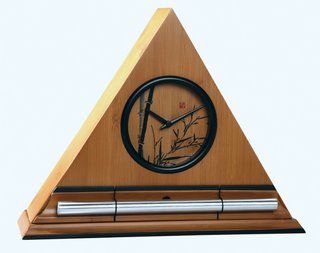 Zen Clock with Gentle Chime to Awaken You Gradually Now & Zen’s Clock and Meditation Timer Store
1638 Pearl Street
Boulder, CO 80302
(800) 779-6383
Posted in Goodness, intention, Meditation Timers, Meditation Tools, mindfulness practice, prayer, Well-being, Zen Timers
 Irises by Ogata Korin Edo 1700s, Tokyo
Ogata Kōrin (1658 – 1716) was a Japanese painter and lacquerer.
 Zen Chime Alarm Clock, Digital Black Lacquer Chime Clock Now & Zen
1638 Pearl Street
Boulder, CO 80302
Posted in Bamboo Chime Clocks, Chime Alarm Clocks, Japanese Inspired Zen Clocks, Meditation Tools, mindfulness practice, Now & Zen Alarm Clocks, Progressive Awakening, Zen Timers
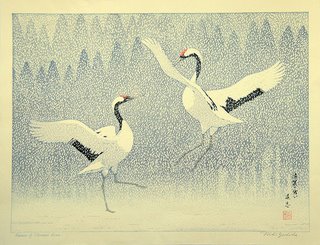 Sousaku Hanga woodblock print by Yoshida Toshi, ca. 1970 Compassionate Listening Practice by Thich Nhat Hanh
When we speak of listening with compassion, we usually think of listening to someone else. But we must also listen to the wounded child inside of us. The wounded child in us is here in the present moment. And we can heal him or her right now.
Practice: “My dear little wounded child, I’m here for you, ready to listen to you. Please tell me all your suffering, all your pain. I am here, really listening.” If you know how to go back to her, to him, and listen like that every day for five or 10 minutes, healing will take place. … Do that for a few weeks or a few months, the wounded child in you will be healed. Mindfulness is the energy that can help us do this. The Tibetan Bowl Timer will gently bring your practice to an end after 10 minutes.
—Thich Nhat Hanh, from Anger: Wisdom to Cool the Flames
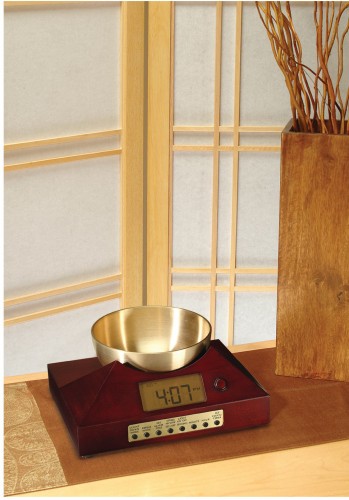 Zen Alarm Clock for a Gentle Awakening with a Bowl Gong and Mindfulness Timer Now & Zen
1638 Pearl Street
Boulder, CO 80302
Posted in Chime Alarm Clocks, Japanese Inspired Zen Clocks, Meditation Tools, mindfulness practice, Natural Awakening, Progressive Awakening, Yoga Timer, Zen Timepiece by Now & Zen, Zen Timers
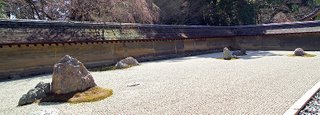 Stone garden in the karesansui style at Ryōan-ji. Karesansui Gardens or “dry landscape” gardens were influenced mainly by Zen Buddhism and can be found at Zen temples of meditation.
In Japanese culture, garden-making is a high art, intimately related to the linked arts of calligraphy and ink painting.
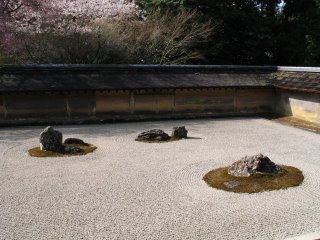 Ryōan-ji Unlike other traditional gardens, there is no water present in Karesansui gardens. However, there is raked gravel or sand that simulates the feeling of water.
The rocks/gravel used are chosen for their artistic shapes, and mosses as well as small shrubs are used to further garnish the Karesansui style (Japanese Lifestyle).
All in all, the rocks and moss are used to represent ponds, islands, boats, seas, rivers, and mountains in an abstract way. Ryoan-ji, temple in Kyoto, has a garden famous for representing this style. Daisen-in, created in 1513, is also particularly renowned.
adapted from wikipedia.org
 Zen Clocks by Now & Zen, Boulder, CO Now & Zen
1638 Pearl Street
Boulder, CO 80302
(800) 779-6383
Posted in Chime Alarm Clocks, mindfulness practice, Natural Awakening, Now & Zen Alarm Clocks, Zen Clocks and Dream Recall, Zen Timers
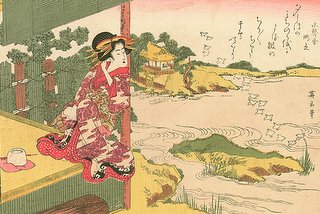 zen garden from tea house, Eizan (1787-1867), Noda River Ukiyo-e Often thought of as tranquil sanctuaries that allow individuals to escape from the stresses of daily life, Japanese gardens are designed for a variety of purposes. Some gardens invite quiet contemplation, but may have also been intended for recreation, the display of rare plant specimens, or the exhibition of unusual rocks.
adapted from wikipedia.org
 Bamboo Alarm Clocks & Meditation Timers Now & Zen
1638 Pearl Street
Boulder, CO 80302
Posted in Chime Alarm Clocks, Japanese Inspired Zen Clocks, Now & Zen Alarm Clocks, Progressive Awakening, Zen Clocks and Dream Recall, Zen Timers
 Arizona The act of being mindful is simply a way of maintaining a higher level of awareness in daily life action and thoughts. One of our favorite ways to practice being mindful is to hike.
Hiking is an outdoor activity which consists of walking in natural environments, often on hiking trails.
Hiking is one of the fundamental outdoor activities on which many others are based. Many beautiful places can only be reached overland by hiking, and enthusiasts regard hiking as the best way to see nature. Hiking over long distances or over difficult terrain requires both the physical ability to do the hike and the knowledge of the route and its pitfalls.
adapted from wikipedia.org
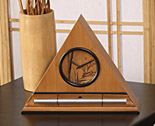 Bamboo Zen Clock
Now & Zen
1638 Pearl Street
Boulder, CO 80302
(800) 779-6383
Posted in Japanese Inspired Zen Clocks, Meditation Timers, Meditation Tools, Now & Zen Alarm Clocks, Zen Timers
« Previous Entries
Next Page »
|
|
|
|